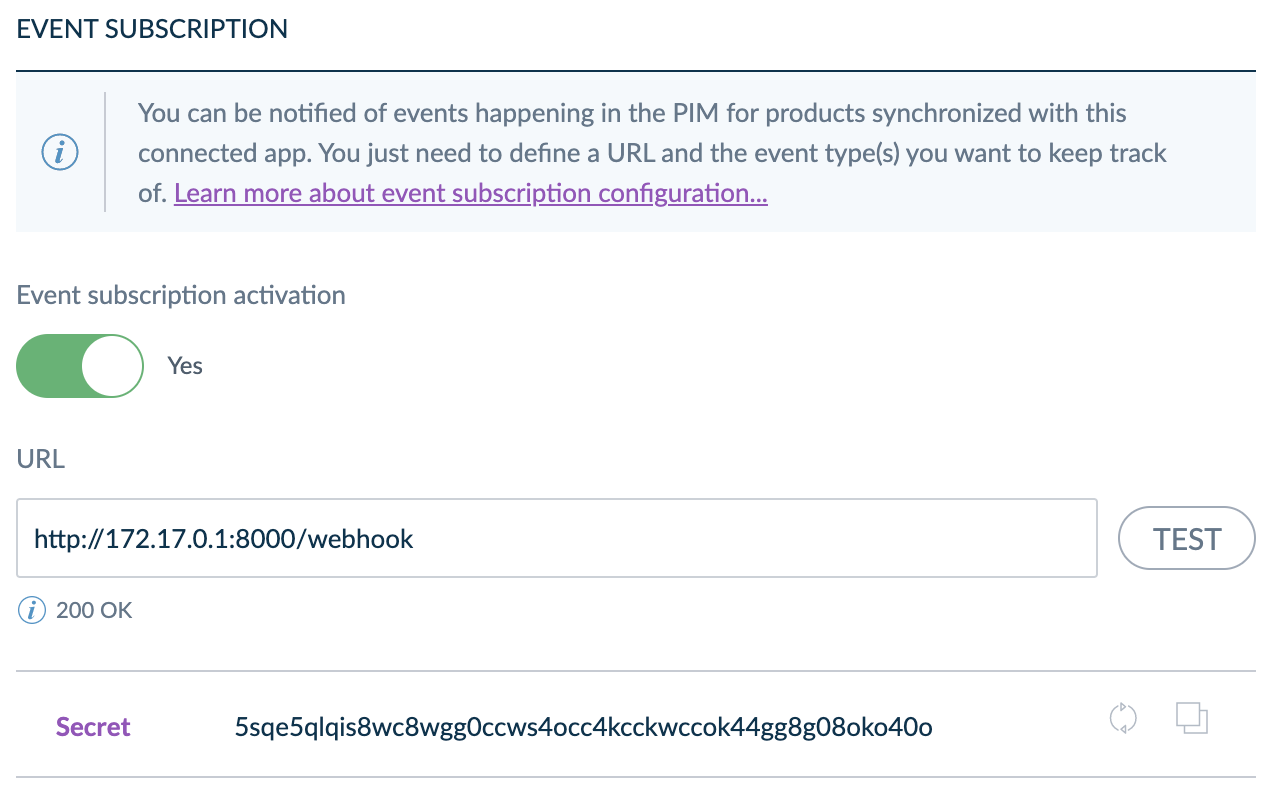Quick start my first webhook
Compatible versions: v5 / v6 / v7/ SaaS
#Step 2 | Create your own Symfony app to display event subscriptions data
#Prerequisites
First of all, you'll need a new Symfony app. To do so, you can follow the Symfony guide and run the $ symfony new display_webhook command.
#Step by step
- Add the route to the
config/routes.yamlfile:
app_webhook:
path: /webhook
controller: App\Controller\WebhookController::post
- Create the controller in
src/Controller/WebhookController.php
<?php
declare(strict_types=1);
namespace App\Controller;
use Psr\Log\LoggerInterface;
use Symfony\Component\HttpFoundation\Request;
use Symfony\Component\HttpFoundation\Response;
class WebhookController
{
// Thanks autowiring!
public function post(Request $request, LoggerInterface $logger): Response
{
// First we extract akeneo's headers.
$timestamp = $request->headers->get('x-akeneo-request-timestamp');
$signature = $request->headers->get('x-akeneo-request-signature');
// If they are null run away. The request does not come from us!
if (null === $timestamp || null === $signature) {
return new Response('', Response::HTTP_UNAUTHORIZED);
}
$body = $request->getContent();
// You should notice that I use a very bad practice here.
// Put that token into your .env file.
$secret = '3kz9y947jps0wggoc84ww80000o0ogs0ssc444w008s8kkcgw';
// This is the way we construct our signature.
$expectedSignature = hash_hmac('sha256', $timestamp . '.' . $body, $secret);
// You must check that the request really comes from us.
// To do it, we provide you the `x-akeneo-signature` header that you rebuilt before and check.
if (false === hash_equals($signature, $expectedSignature)) {
return new Response('', Response::HTTP_UNAUTHORIZED);
}
// Now let's check that the request is fresh.
if (time() - (int) $timestamp > 300) {
throw new \Exception('Request is too old (> 5min)');
}
// And now, do your stuff!
$logger->debug($body);
// You acknowledge you received the event.
return new Response();
}
}
- Launch your local webserver with
$ symfony serve --port=8000.

For the need of this quick start, I'm using Docker, that's why I map and expose the 8000 port. My Symfony binary is located in bin.
- Almost done! Go back to your Akeneo PIM and configure the connection event subscriptions by replacing your test URL with your new URL. Then save and test it. Here is mine:

- Finally, update a product with the API and here is the result:

{
"events":[
{
"action":"product.updated",
"event_id":"551f7108-3b59-4064-a923-fefb4e707f05",
"event_date":"2021-01-06T13:37:24+00:00",
"author":"magento_0000",
"author_type":"api",
"pim_source":"http:\/\/localhost:8080",
"data":
{
"resource":
{
"identifier":"AKNSTK",
"enabled":true,
"family":null,
"categories":["goodies","stickers"],
"groups":[],
"parent":null,
"values":
{
"main_color":[{"locale":null,"scope":null,"data":"purple"}],
"price":[{"locale":null,"scope":null,"data":[{"amount":"2.00","currency":"EUR"},{"amount":"3.00","currency":"USD"}]}],
"name":[{"locale":null,"scope":null,"data":"lolololo"}],
"description":
[
{"locale":"de_DE","scope":"print","data":"Akeneo Sticker"},
{"locale":"en_US","scope":"print","data":"Akeneo trololo azing sticker !"},
{"locale":"fr_FR","scope":"print","data":"Sticker Akeneo"}
]
},
"created":"2021-01-04T13:34:33+00:00",
"updated":"2021-01-06T13:37:24+00:00",
"associations":
{
"PACK":{"products":[],"product_models":[],"groups":[]},
"UPSELL":{"products":[],"product_models":[],"groups":[]},
"X_SELL":{"products":[],"product_models":[],"groups":[]},
"SUBSTITUTION":{"products":[],"product_models":[],"groups":[]}
},
"quantified_associations":{}
}
}
}
]
}